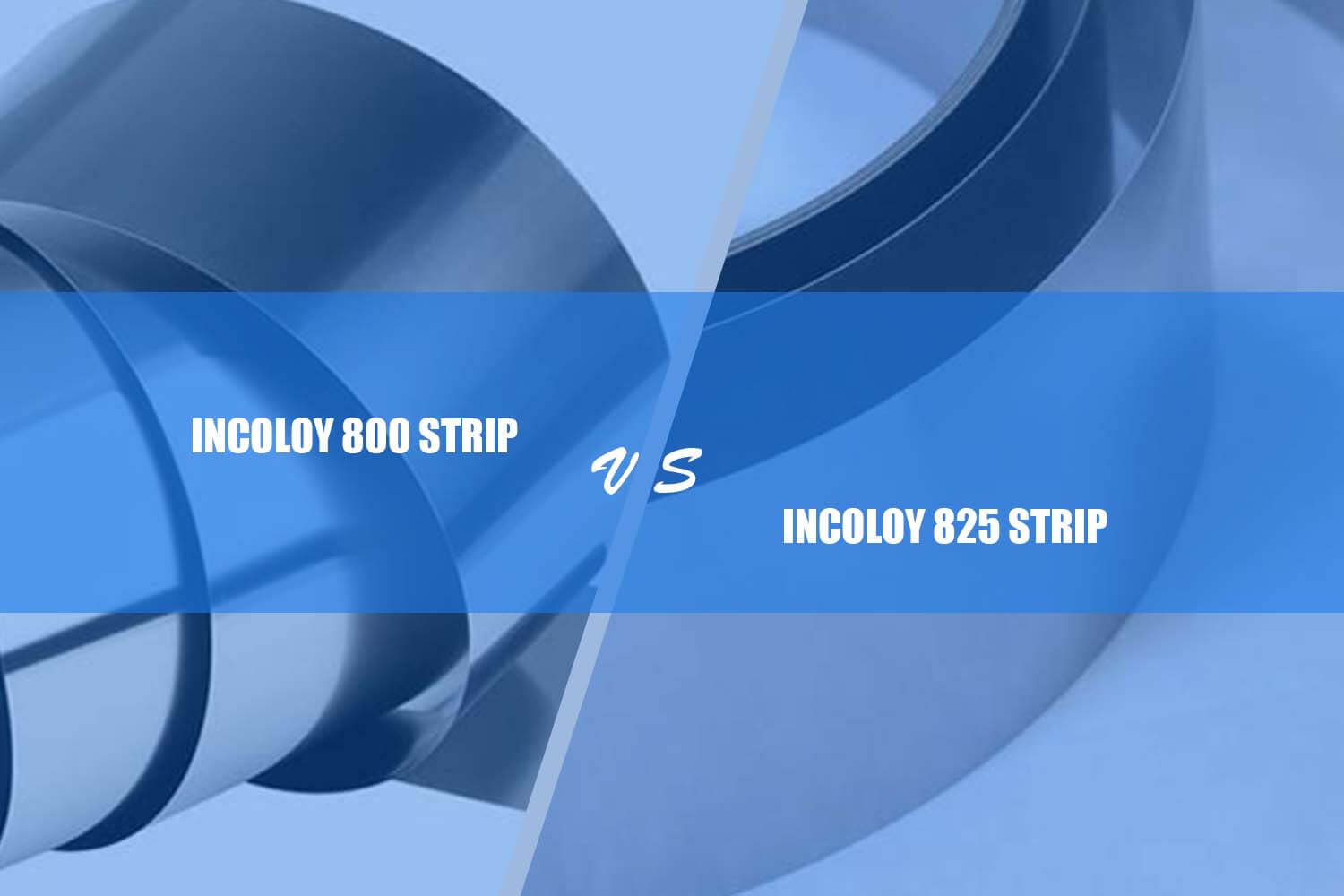Adding molybdenum and copper in Incoloy 800 strips makes a super alloy called Incoloy 825.
The Incoloy 825 strip is more corrosion-resistant than Incoloy 800 strip. The Incoloy 800 strips have nickel, iron, and chromium in composition, and the Incoloy 825 strips have molybdenum and copper, along with nickel, iron, and chromium.
The density of Incoloy 800 strip is 7.94 g/cm³; on the other hand, the Incoloy 825 strip has a density of 8.14 g/cm³.
Incoloy 825 has a better level of purity and better control of harmful ingredients than Incoloy 800.
With nickel, iron, and chromium contents, Incoloy metal products are super alloys that can withstand oxidation and carbonization at high temperatures.
In comparison, the stability of the alloy at high temperatures is highly influenced by the silicon and manganese contents.
These two impurity elements can be better controlled in Incoloy 825. As a result, Incoloy 825 strips are more durable than Incoloy 800 strips. Overall, Incoloy 825 strips have improved control over impurity elements.
Do you know more what is the difference between two nickel alloy strips?
Let’s keep reading.
What is Incoloy 800 Strip?
A popular alloy strips for building equipment that needs to be corrosion- and heat-resistant, strong, and stable for service up to 1500°F (816°C) is Incoloy 800.
Because of its nickel concentration, Incoloy 800 strips resist stress corrosion cracking and provide basic corrosion resistance to many aquatic environments.
It provides rupture and creeps strength and oxidation, carburization, and sulfidation resistance at high temperatures.
The Incoloy 800 strip can preserve its stability and austenitic structure even after extended exposure to extreme temperatures.
The tensile strength of the Incoloy 800 strip is about 600 Mpa in the annealed state, and the yield strength is about 275 Mpa.
The Incoloy 800 strips have machining properties the same as other iron-based alloys.
By using common welding techniques, Incoloy 800 strips can easily be welded with similar filler metal.
The excellent ductility of the Incoloy 800 strip allows it to be produced using traditional techniques.
After cold working, Incoloy 800 strips can be annealed. The Incoloy 800 should be air-cooled after 15 minutes of annealing at 982 °C (1800 °F).
What is Incoloy 825 Strip?
Molybdenum, copper, and titanium are added to the nickel-iron-chromium alloy for making Incoloy 825 strips.
Due to the alloy’s chemical makeup, it is exceptionally resistant to many corrosive conditions.
The wide range of applications for Incoloy 825 strips is due to its resistance to both general and specific corrosion under various conditions.
The Incoloy 825 strip is resistant to acids and reducing agents due to the molybdenum and copper contents.
Chromium provides resistance to oxidizing environments, including nitric acid solutions, nitrates, and oxidizing salts.
Strips made of Incoloy 825 are particularly resistant to sulfuric and phosphoric acids.
These Incoloy 825 strips are employed in manufacturing acids, oil, and gas well pipes, pollution-control machinery, and nuclear fuel reprocessing.
High levels of corrosion resistance are seen in Incoloy 825 strip. It is resistant to corrosive attack, pitting, crevice corrosion, and strain cracking in oxidizing and reducing conditions.
For pressure vessels operating at up to 525°C, Incoloy 825 is approved.
The Incoloy 825 strip mechanical characteristics enable outstanding performance in challenging circumstances.
The microstructure can change when subjected to temperatures above 1000°F.
Incoloy 800 Strip vs. Incoloy 825 Strip Comparison
Incoloy 825 strips contain more nickel and less iron. It shows that it has superior basic corrosion resistance to Incoloy 800 strips. The high chromium content of these alloys ensures their strong oxidation resistance.
Incoloy 825 strip has a better purity level and stricter regulation of hazardous ingredients than the Incoloy 800 strip.
The sulfur contents significantly influence the transient performance of the alloy.
Incoloy 800 strips offer superior transient performance than Incoloy 825 strips overall because the sulfur content regulation for 800 is tighter than it is for 825.
The high chromium content of these alloys ensures their strong oxidation resistance.
Incoloy 825 strips have molybdenum contents. Compared to Incoloy 800 strips, it is more resistant to reducing environments (such as sulfuric and phosphoric acids). Molybdenum also helps with corrosion in crevices and resistance to pitting.
Incoloy 825 strips also have excellent resistance to corrosion at room temperature due to the additional copper element.
When compared overall, Incoloy 825 strips have more excellent corrosion resistance than Incoloy 800 strips.
What are the Incoloy 800 Strips and Incoloy 825 Strips Applications?
Applications of Incoloy 825 strips in the chemical process industry range from thermowell and sensors to pumps.
These strips are also used in valve parts for hydrogen and ethylene furnaces and parts for fertilizer and ammonia facilities.
Vessels for treating seawater, ammonium sulfate, pickling acids, sulphuric and phosphoric acids, and sulphuric acid are typical components.
The Incoloy 825 strips are widely used in the oil and gas industries. These strips are also used in power generation and are easily weldable by standard processes like TIG and MIG welding.
The nickel-iron-chromium alloy Incoloy 800 strips exhibit various properties and find usage in a wide range of applications. This alloy can keep its austenitic structure.
These Incoloy 800 strips are frequently used in industries including paper pulp, the automobile industry, and nuclear power plants.
These Incoloy 800 strips are mostly used in the piping system and heat exchangers in nitric acid media in the petrochemical and chemical processing industries where resistance to chloride-stressed corrosion is required.
Which one between Incoloy 800 Strip and Incoloy 825 Strip is better?
Incoloy 825 strips will have greater overall strength and corrosion resistance than Incoloy 800 strips because more copper and molybdenum were added to improve the solid solution strengthening effect.
But there isn’t a clear distinction between the two alloys’ strengths. Corrosion resistance is the main difference between these two alloys.
Conclusion
Both alloys have outstanding properties and are most widely used in industries.
The strength of Incoloy 800 strips and Incoloy 825 strips is approximately the same.
The corrosion resistance of incoloy825 strips is better than Incoloy 800; therefore, these strips are mostly used in complex environments.
HZW is one of the leading stainless steel strips and nickel alloys strips suppliers in China, experts in manufacturing and exporting precision stainless steel strips products with rich experience.
If you want to purchase incoloy 800 strips and incoloy 825 strips products, why not contact us here for saving your time and money?












